This Breathtaking 8-suite Resort in Bhutan Is One of the Most-anticipated New Hotels in Asia — and We Were Among the First to Stay
Join travel journalist Chris Schalkx as he checks in to andBeyond Punakha River Lodge, Bhutan.
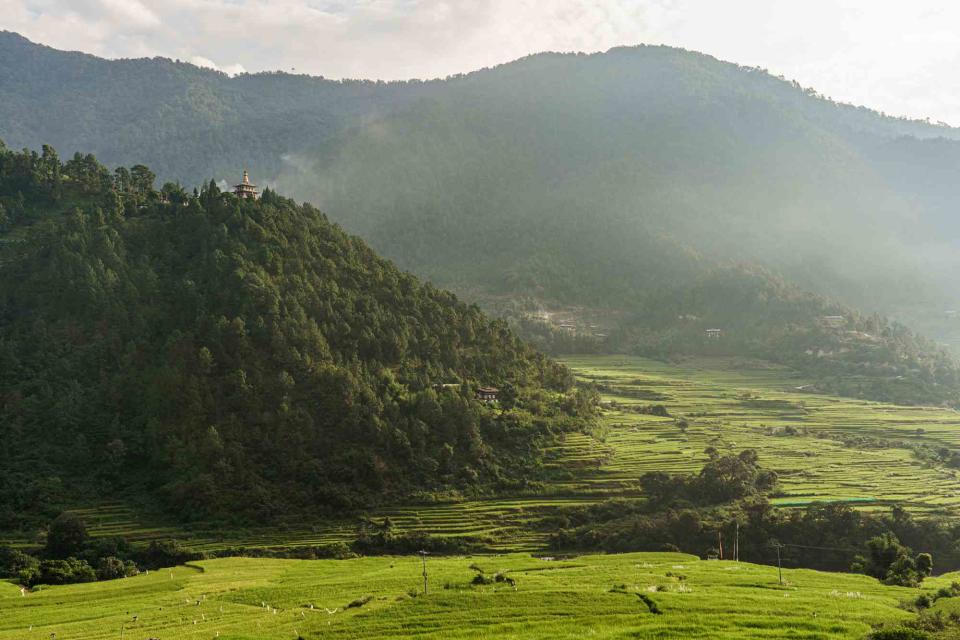
Chris Schalkx/Travel + Leisure
"NO HURRY, NO WORRY," reads a hand-painted roadside sign on the way to Punakha, a tropic-tinged valley in the heart of Bhutan. It’s an apt descriptor for this former capital, where even for Bhutan’s already laid-back standards, life seems to slow down to an even more syrupy pace.
I’ve taken three trips around Bhutan, and Punakha has become one of my favorite Bhutanese valleys for good reason: the Punakha dzong, a whitewashed fortress wedged between two rivers, is one of the kingdom’s oldest and prettiest. And thanks to its year-round balmy weather, Punakha is one of the only places in Bhutan where resorts come with outdoor swimming pools – a welcome perk after a long day of temple-hopping around the surrounding countryside.
andBeyond Punakha River Lodge, Bhutan
With just six tented suites and two family-friendly villas, the camp feels delightfully intimate.
Bathrooms in the tented suites come with a skylight in their bamboo-covered ceiling, making them perfect for stargazing from a hot herbal bath on clear nights.
The pop-up cocktail carts, candlelit destination dinners, and excursions are all included in the rate, so there’s no need to worry about surprises on the bill.
One of Bhutan’s prettiest stupas, the Khamsum Yuelley Namgyal Chorten, is visible from the restaurant and just a 40-minute hike away.
No wonder, then, that luxury hospitality company and tour operator andBeyond recently pitched up its first Bhutanese camp in a river bend between Punakha’s rice fields. “The views are beautiful, but Punakha is also central enough for us to operate excursions to various areas like Gangtey, Gasa and Laya,” says Rishi Sarma, andBeyond Punakha River Lodge’s general manager. “It’s an activity-rich destination full of hikes, rafting, mountain biking, and fishing. And with its proximity to red pandas and snow leopards, we can hone the wildlife conservation efforts andBeyond is known for.”
Spoiler alert: stop reading if you’re already planning a visit, because Namgay, the camp’s experience manager, had lots of surprises up his tartan-patterned sleeves. One steamy morning, when I reached the Khamsum Yuelley Namgyal Chorten stupa after a 40-minute uphill hike, he and his team awaited me with a picnic breakfast of fresh juices, flaky pastries, and Amarula-spiked coffee. Another day, after I had finished a tour around the Punakha dzong and the sun began to dip behind the mountains, he appeared with a pop-up cocktail bar on a nearby riverbank – ice-cold G&Ts, mini-quiches, chili-cheese poppers, and all.
The Rooms
As specialists in Africa’s tented safari camps, it’s no surprise that andBeyond chose a similar setup for its first Asian outpost. “The idea was to bring in the real Bhutan,” Sarma says. “It needed to feel wild and not too manicured. Tents lend themselves well to this immersion into the wilderness, without leaving a carbon-heavy footprint on the land.”
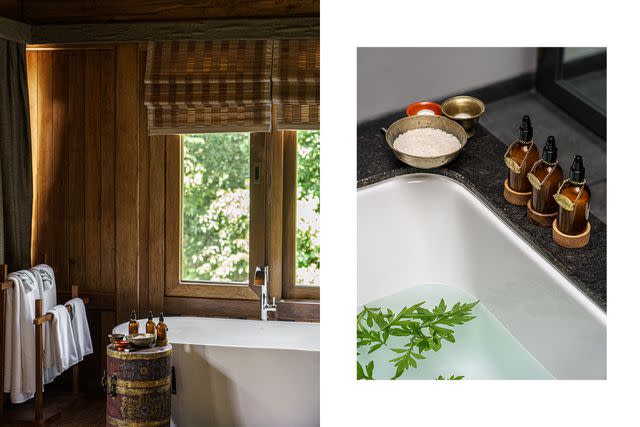
Chris Schalkx/Travel + Leisure
I stayed in one of the six tented suites, which was, in fact, more like a tent-villa hybrid. Pitched up in a traditional Bhutanese timber frame, the bedroom area had a canvas ceiling and wall-spanning windows that could zip open to let the outside in. The decor could only be described as Bhutanese chic: a mix of wood and bamboo, with jolts of blue suede (“inspired by the blue poppy, Bhutan’s national flower,” Sarma says.), licks of brass, and vintage carpets adding a pop of color. I particularly liked my bed’s headboard, which was covered in kaleidoscopic local fabrics made by Renew, a Thimphu-based nonprofit that helps women around Bhutan learn new skills (weaving, in this case) to generate an income. The ensuite bathroom eschewed canvas walls for gray slate and stacked sandstone. There was an outdoor shower for balmy summer days (in addition to a spacious one indoors), and a brass-clad bathtub positioned right under a skylight in the bamboo ceiling for stargazing on clear nights.
For more space, there’s the 1,615-square-foot River House, a two-level villa built like a traditional farmhouse on one of the loveliest spots around the property. From the plunge pool on its verandah (or the bathtub near the window upstairs), you can watch the river rush past and the Himalayan peaks on the horizon. Surrounded by tall grasses farther back on the property, the Family Suite is even larger (3,337 square feet, to be precise) and features two bedrooms separated by a living- and dining area, alongside a large private pool and multiple pillow-strewn terraces.
Food and Drink
The lobby flows into the camp’s only restaurant, but during my four-night stay, I only had dinner there once (because it rained). Instead, the team had set up my table at a different spot around the property every night – near the fire pit, between tangles of prayer flags in the citrus orchard, or on a pretty spot along the river. Led by the amiable South African chef Rudolf van der Westhuizen, the kitchen team draws on local ingredients to design a new menu every night, which included, during my visit, chicken ramen, beef curry, and Himalayan trout ceviche. They also got creative with Bhutanese food: apart from a brilliant dinner spread of my favorite Bhutanese classics (kewa datshi potatoes and cheese among them) I requested one night, some menus included playful riffs on local comfort foods such as momos (dumplings) with apple and arancini-like bites stuffed with ema datshi (chili and cheese).
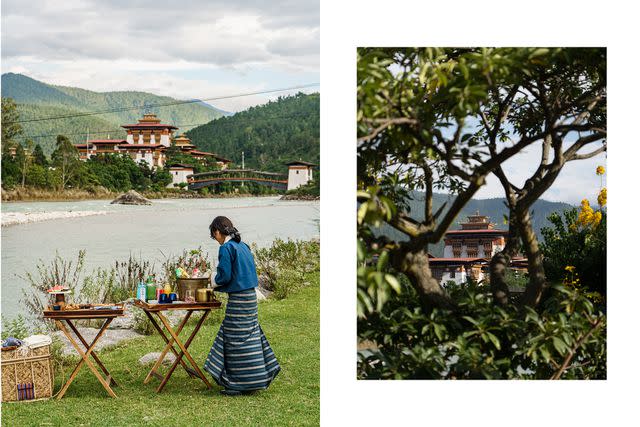
Chris Schalkx/Travel + Leisure
Experiences and Amenities
The camp has a lounger-lined pool and both indoor- and outdoor yoga shalas overlooking the rice fields. And while they’re lovely, it’s the off-camp activities where andBeyond really shines – those are what you come to Punakha for after all. There are guided tours around that pretty dzong, of course, but also visits to temples and nunneries few others get to see, such as the Sangchhen Dorji Lhuendrup Lhakhang Nunnery, which has a stunning mountaintop setting. For activities of a more active kind, the camp can organize rafting trips down the Mo Chu river; treks through the surrounding valleys; and mountain bike bike rides to the old-timey villages dotting the hillsides.
The Spa
The spa was still under construction at the time of my visit (a few weeks after the camp started welcoming guests), but when it opens, it’ll be a small village of treatment rooms for all-natural Bhutanese massages and mineral-rich herbal hot stone baths.
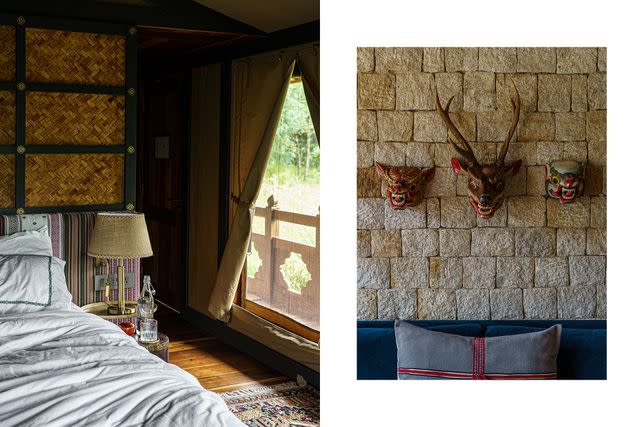
Chris Schalkx/Travel + Leisure
Family-friendly Offerings
Most of the activities – from Bhutanese darts games to cooking classes in the outdoor kitchen – are fun for all ages. The Family Villa comes with two bedrooms and a private swimming pool, while the sofas on the ground floor of the River House can be converted into beds.
Accessibility and Sustainability
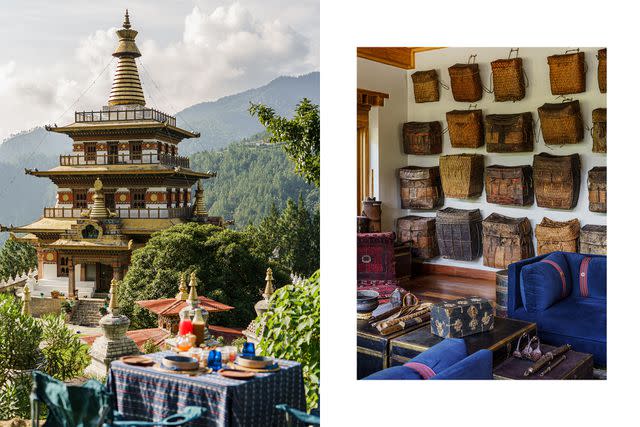
Chris Schalkx/Travel + Leisure
The bedrooms in the Family Villa are wheelchair-accessible, and ramps can be arranged to cover some of the steps around the property. That said, the landscape is hilly and pathways are made from stepping stones, leaving most of the resort off-limits to guests with limited mobility. On the sustainability front, single-use plastics are banned and the camp sources almost all of its kitchen ingredients locally. Like its African andBeyond counterparts, tents were chosen as a way to tread lightly on the land – a plot of which 75 percent is allocated to local farmers to grow crops. Besides, the camp aims to uplift the local community by hiring almost 80 percent of its staff from local villages, and most of them receive on-the-job training for this first foray into their hospitality careers.
Location
Every visitor in Bhutan has to travel with a guide and driver (which andBeyond can arrange through its tour-operator division), which puts Punakha’s sights within easy reach. The valley’s main draw, one of Bhutan’s oldest — and prettiest — dzongs, is about a 20-minute drive away, while the drive to the of-visited Chimi Lhakhang (fertility temple) will take about 45 minutes. There are plenty of sights within walking distance, too: the Khamsum Yuelley Namgyal Chorten, a gold-rimmed hilltop stupa visible from the resort, is reachable via a 40-minute hike. Punakha lies some three hours from Thimphu, and four hours from Paro airport, which makes stopping here worthwhile even if you’re visiting Bhutan for only a few days.
How to Get the Most Value out of Your Stay
The tented suites, which are the entry-level rooms at andBeyond Punakha River Lodge, start from $890 per night. Not cheap, but a fair bit more affordable than the other five-star competitors in the valley. Plus, everything from meals to drinks and activities (with the exception of spa treatments and river-based excursions) is included in that rate. But that’s not all: Bhutan’s Sustainable Development Fee will cost you $100 for every day you spend in the Kingdom, and you’ll need to hire a guide and driver. To make a trip hassle-free, your best way is booking through one of the travel agencies specializing in Bhutan, such as andBeyond’s tour-operator arm which takes care of everything from flight bookings to visas — and might even be able to hook you up with some extra perks at the camp.
For more Travel & Leisure news, make sure to sign up for our newsletter!
Read the original article on Travel & Leisure.

